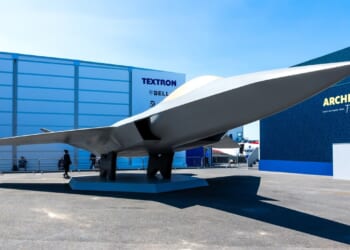If even a fraction of what China claims of the missile is true, it is a formidable threat indeed.
China continues its military modernization breakout at a staggering pace. On some level, the Chinese exaggerate their capabilities—as every military does from time to time. But the notion that everything China has, or is building, amounts to a fabrication is a dangerous form of complacency. China is a high-technology superpower, and it is leveraging its advanced technological capabilities to create a world-class military-industrial ecosystem that rivals even that of the United States.
In the realm of modern military technology, the DF-100 supersonic missile is one of China’s most formidable advancements. The missile plays very well into China’s overall strategy of crafting complex webs of air weapons to saturate the defenses of rival aircraft carriers, bases, and aircraft that might pose a threat to the Chinese military in places like the Taiwan Strait, South China Sea, and East China Sea.
The DF-100 Missile’s Specs
Designed to deliver high-precision strikes over vast distances and developed by the People’s Liberation Army Rocket Force (PLARF), the DF-100 has garnered global attention for its real potential to reshape regional power dynamics.
DF-100 is part of the broader Dongfeng (DF) series, which translates to “East Wind.” The missile was first publicly unveiled during the 2019 military parade commemorating the 70th anniversary of the People’s Republic of China. This event showcased the DF-100 as the latest iteration in the “Long Sword” cruise missile family, emphasizing supersonic speed and extended range.
Development likely began in the early 2010s, building on previous models like the CJ-10. By 2019, at least one PLARF unit had begun receiving operational DF-100 systems, with full operational capability achieved by 2022. Recent footage released by the Chinese state media in 2025 has provided rare insights into its development, highlighting launches from mobile transporter-erector launchers (TELs) and potential air-launch from bombers like the Xi’an H-6K.
DF-100 incorporates supersonic propulsion from the outset, addressing vulnerabilities in slower systems against advanced air defenses.
At the core of the DF-100’s prowess are its impressive technical specifications. The missile has a payload capacity exceeding 1,000 pounds. It is powered by a ramjet engine, enabling sustained supersonic flight—exceeding Mach 4, or more than 3,000 miles per hour—throughout most of its trajectory. Recent analyses suggest the weapon has an operational reach of 1,854-2,485 miles. Its guidance system is thought to combine inertial navigation, satellite position (Beidou), and terminal active radar or infrared homing.
America Underestimates the DF-100 at Its Own Peril
The DF-100 excels in both land-attack and anti-ship roles, posing a multi-faceted threat. Its supersonic speed reduces reaction time for adversaries, complicating defenses like the US Terminal High Altitude Area Defense (THAAD) system. Maneuverable air rudders in the terminal phase allow it to adjust course, evading interceptors and striking with high precision.
As a “carrier killer,” the DF-100 can target large naval vessels, including aircraft carriers, from regional standoff distances. Its hypersonic-like terminal dash enhances lethality against moving targets. The missile volley-firing capability—launched in salvos—can overwhelm enemy defenses, integrating seamlessly with other systems, like the DF-17 hypersonic glide vehicle.
If even a fraction of what China claims of the missile is true, it is a formidable threat indeed. Many Western commentators are given to undercutting and minimizing the technological achievements of China and their military technology advances. Whatever their reasons for doing so, it makes it that much more difficult to encourage the US government to invest in viable countermeasures.
The DF-100 is real. It is a serious challenge to US power projection in the Indo-Pacific. And unless the United States takes the threat seriously, it will wreak havoc on any US force possibly deployed against it.
About the Author: Brandon J. Weichert
Brandon J. Weichert is a senior national security editor at The National Interest. Recently, Weichert became the host of The National Security Hour on America Outloud News and iHeartRadio, where he discusses national security policy every Wednesday at 8pm Eastern. He is also a contributor at Popular Mechanics, and has consulted regularly with various government institutions and private organizations on geopolitical issues. Weichert’s writings have appeared in multiple publications, including The Washington Times, National Review, The American Spectator, MSN, The Asia Times, and countless others. His books include Winning Space: How America Remains a Superpower, Biohacked: China’s Race to Control Life, and The Shadow War: Iran’s Quest for Supremacy. His newest book, A Disaster of Our Own Making: How the West Lost Ukraine is available for purchase wherever books are sold. He can be followed via Twitter @WeTheBrandon.
Image: Shutterstock / Anelo.
















